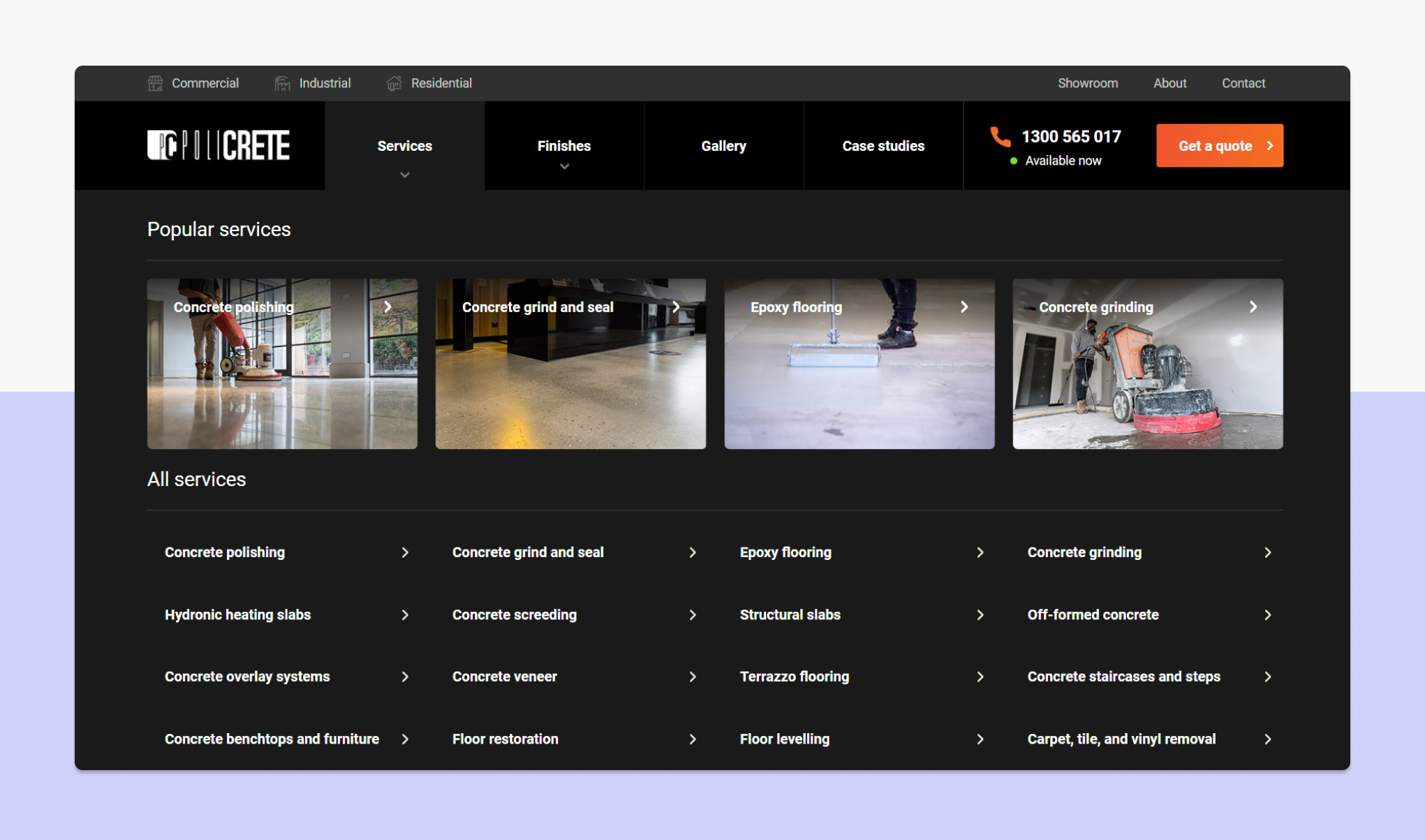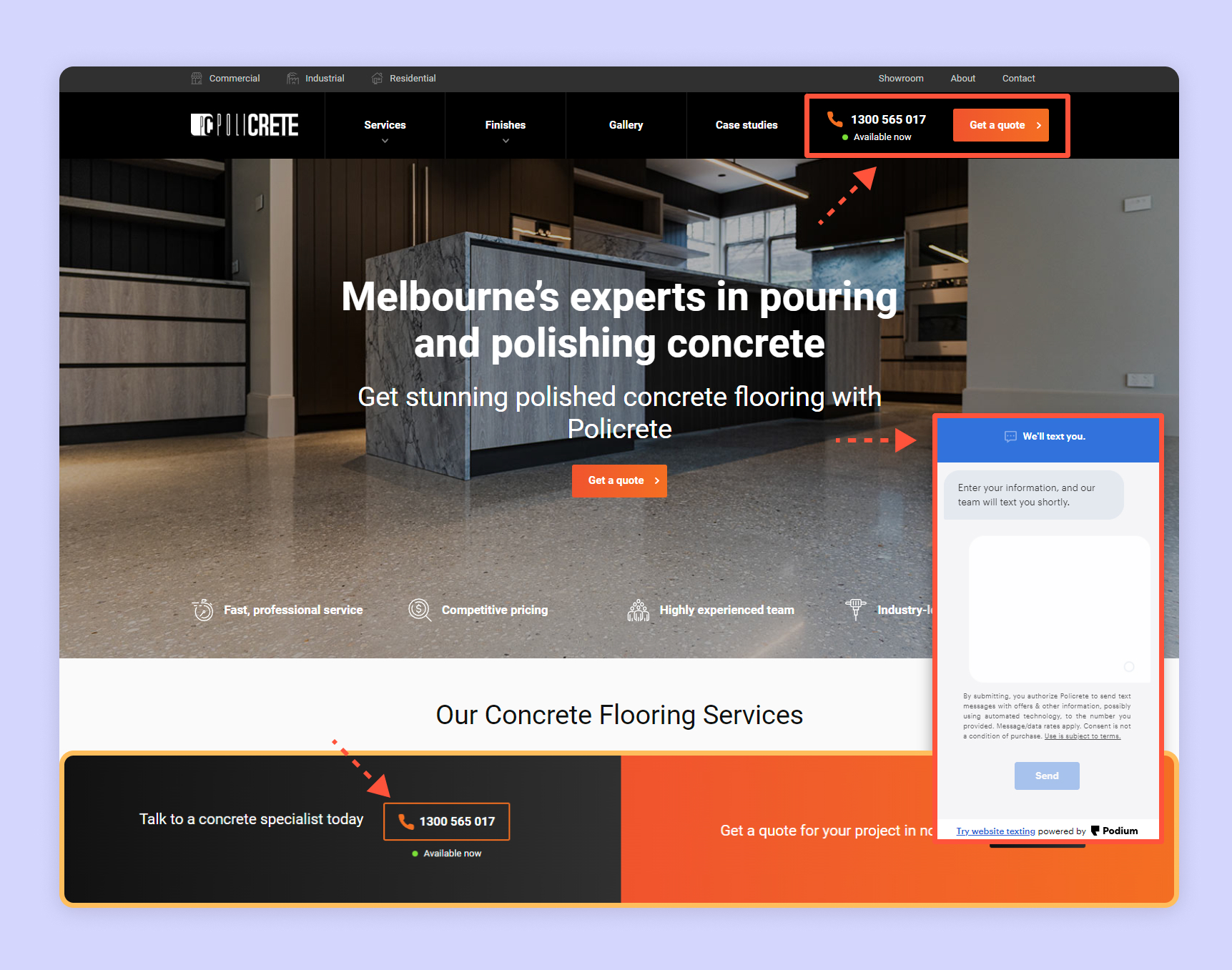Improve your UX and boost customer engagement through our in-depth case study. Learn top tips for improving UX from the CRO experts.
12 proven steps to elevate your website's user experience and boost conversions

Did you know that 88% of online consumers are less likely to return to a website after a bad experience? If you're struggling to keep visitors on your site, improving user experience (UX) is crucial.
But where do you start?
This comprehensive guide will show you how to improve your website's UX with practical tips and strategies backed by data. Discover the steps required to create a seamless and enjoyable user experience that engages visitors and drives more conversions.
Read until the end as we share exactly how we achieved our great results for Policrete.
Keen to check out the full Case Study?
[tip_box]
Policrete Case Study
The Policrete website has undergone a remarkable transformation, with over 400% improvement in conversion rate. By creating an improved user experience and emphasising their value proposition rather than price point, the team at Policrete have achieved fantastic results that will help them secure high-value projects for years to come.
[/tip_box]
[feature_link]See the Policrete Case Study here[/feature_link]
Ready to learn the steps to provide an awesome user experience? Let’s do this!
1. Create a user-centred design process
User-centred design (UCD) prioritises the user in the design process, incorporating their needs and behaviours. Using a UCD approach, businesses can reduce bounce rates, increase conversions, and ensure their website meets the users' needs.
[tip_box]
Want to boost your website's conversion rates?
Adopt a user-centred design process!
Businesses that adopt a user-centred design process are able to increase website conversion rates by up to 200%. By prioritising the needs and preferences of your target audience, you can create a website that resonates with visitors and drives more conversions.
Here are some tips to get you started:
- Conduct user research to understand your audience's goals and pain points
- Use this insight to inform your website's design and content
- Test and iterate your website's design to ensure it's meeting your users' needs
- By taking a user-centred approach, you can improve your website's user experience and increase your chances of success.
[/tip_box]
2. Use bounce rate to determine the effectiveness of your UX

Content that fails to engage or lacks a clear call-to-action can lead customers to quickly abandon your website, resulting in an increased bounce rate.
Bounce rate is a great metric for UX because it measures the percentage of visitors to a website who leave after only viewing one page. High bounce rates can indicate a poor user experience, such as slow loading times, confusing navigation, or irrelevant content. Website owners can improve the overall UX by analysing bounce rate data to determine the issues with the user experience and implementing changes that engage site visitors for longer.
3. Improve UX with CRO services
Conversion rate optimisation (CRO) is the process of optimising a website to increase the number of conversions. CRO services can help businesses to optimise their website designs to improve UX, resulting in reduced bounce rate, increased conversions and higher ROI.
[tip_box]
Maximising returns with UX and CRO services
Did you know that every dollar spent on UX can bring in between $2 and $100 in return?
Enhancing UX and optimising conversions is crucial for any website's success in the digital landscape. Without understanding how users interact with your site, it's impossible to create an effective CRO strategy that focuses on your site's specific issues and pain points.
Achieve maximum returns on your investment with these
- A/B test to compare website versions and find the best UX design
- Use heat maps and user recordings to identify user interaction and friction areas
- Gather user feedback through surveys and make necessary changes to improve the user experience
[/tip_box]
4. Landing pages with immediate impact

By displaying at least 40% of your product range on your website's landing pages, you give visitors a clear and comprehensive overview of your offer.
By showcasing a significant portion of your offerings on your web pages, you also demonstrate your credibility and expertise, instilling trust in visitors and encouraging them to explore your site further. It also helps to eliminate uncertainty and confusion that can lead to higher bounce rates.
EngineRoom designed dedicated category pages for Policrete relevant to target audiences from relevant industries. This helps ensure the business looks capable of serving the needs of specific users because it shows Policrete’s experience within industries where its potential customers work.
Using this technique, you can create an engaging and user-friendly experience that satisfies customers, builds trust and leads to higher conversion rates.
5. Promote your Unique Selling Points (USPs)

Promoting your business's unique selling points (USPs) is crucial for optimising conversion rates and improving the user experience. By highlighting what sets your business apart from the competition, you can immediately capture the attention of website visitors and establish why they should choose your products or services.
Adopting this strategy creates a sense of value and sets the tone for a positive user experience. Showcasing your USPs on your landing page helps visitors understand why they should invest their time and resources in your business rather than browsing elsewhere. By emphasising your USPs, you can differentiate yourself from competitors and make a strong impression that motivates visitors to take action.
6. Easy navigation

Navigation is often considered the single most critical aspect of user interface design. Getting it right helps users navigate to what they are looking for on a website and interact with the content. A website with poor navigation can cause frustration for users and result in a high bounce rate.
Policrete's website is a great example of how navigation can be made intuitive and simple. The website uses a clear and simple menu structure that is easy to use, making it easy for online visitors to find what they are looking for. Using clear headings and subheadings helps your website users understand its key features and find the information they need.
EngineRoom researched methods of how users search and developed these into two categories to satisfy different users looking for a service or by a specific finish. With specific user needs appropriately catered for and built into the site architecture, we saw a big lift in conversions on the site.
7. High-quality images

Visuals play a critical role in UX, as they can help to instantly engage customers and communicate information in a way that is easy to understand. High-quality visuals, such as images and videos, can help customers understand the products and services offered by a business. They can also be used to create an emotional connection with the customer.
To drive higher engagement and ensure your landing pages reflect the breadth and quality of the solutions you can provide, ensure visuals play a prominent role in your web design.
Images can convey a lot of information and set a website's mood and tone. Policrete's website features high-quality images showcasing its wide range of products and services, helping customers better understand what they offer.
8. Mobile-friendly design

With the growing use of mobile devices, it is essential that websites are optimised for mobile devices with a responsive design. A mobile-friendly website provides a seamless experience for users, regardless of their device. This is critical, as a website that is not optimised for mobile devices can result in a poor user experience, leading to high bounce rates and lost customers.
A study conducted by Google found that 61% of users are more likely to leave a website that is not optimised for mobile devices, highlighting the importance of making a website mobile-friendly. By optimising the website for mobile devices, businesses can improve the overall user experience and drive conversions amongst mobile users.
More and more people are using their smartphones to access the web, so websites must be mobile-friendly. Policrete's website is fully responsive, meaning it adapts to the screen size of the device being used, providing a seamless experience on desktop, tablet, or mobile.
9. Clear and concise information

Content is the backbone of any website; consumers demand quality material to keep them interested. Content, including product and service descriptions, blog posts and case studies, should be concise, engaging, and well-structured, with headings, subheadings, and bullet points.
Policrete's website is a great example of how content can be made easy to read and understand. The website engages its audience with clear and concise language, with headings, subheadings, and bullet points to break up large blocks of text.
Policrete's website provides detailed product and service information, including specifications, benefits, and applications. The information is presented in a way that is easy to comprehend, helping customers make informed decisions.
10. Fast and efficient
Page load time is critical to UX, as users are unlikely to wait for a slow-loading website. A website that takes too long to load can cause frustration for users and result in a high bounce rate. Optimising your website’s loading page speed is important to ensure that it provides a seamless experience for users.
A recent study found that 47% of users expect a website to load in 2 seconds or less! This shows just how important optimising website speed is and how it can significantly impact UX and customer satisfaction.
Policrete's website is fast and efficient, providing a seamless user experience. It's crucial to optimise your website for speed, with fast-loading images and a streamlined codebase.
11. Engaging and interactive

An engaging and interactive website can keep customers on the site longer and increase conversions. Policrete's website features a project portfolio and testimonials, helping engage visitors and providing a memorable user experience. Adding interactive key elements to your website, such as a search feature, can help engage visitors and improve UX.
On the flip side, if your site shows a 404 error, it can negatively affect UX, as visitors cannot access the content they were looking for and may become frustrated and leave the website.
A 404 error is an HTTP status code indicating that the requested page or resource could not be found on the server. To check for 404 errors, you will need access to Google Search Console or a technical auditing tool. Once it’s set up, check for any crawl errors.
12. Easy contact information

Customers should be able to contact a business easily by phone, email or through a contact form. Policrete's website features clear contact information and a call to action, making it easy for customers to get in touch. Ensure your website has clear contact information and a simple way for customers to get in touch.
We created clear conversion methods for Policrete’s site, allowing customers to contact the business in their preferred way.
✓ Live chat (Podium, chat and communication)
✓ Quote
✓ Phone call
Leverage our 12 expert tips and deliver a better experience for your web visitors
Improving a website's user experience (UX) drives conversions and improves ROI. Following the steps outlined in this post, businesses can improve the overall user experience and drive conversions, resulting in increased success and profitability. Whether conducting a user-centred design process, using white space, or utilising CRO services, businesses have a wide range of tools to help improve UX and achieve their goals.
[free_strategy_session]
Improve the user experience on your website with a free strategy session*
We specialise in website design and optimisation services that deliver a better UX and a significant boost to your website conversions. Book your free 90-minute strategy session with one of our digital advisors to get started.
- Get a better understanding of your business
- We generate a detailed report from your strategy session
- Understand your priorities and next steps
- Speak to a senior digital advisor today
[/free_strategy_session]
Keen to hear more about how to improve the UX of your website? Book your free strategy session with a senior digital advisor at EngineRoom today to get started.






